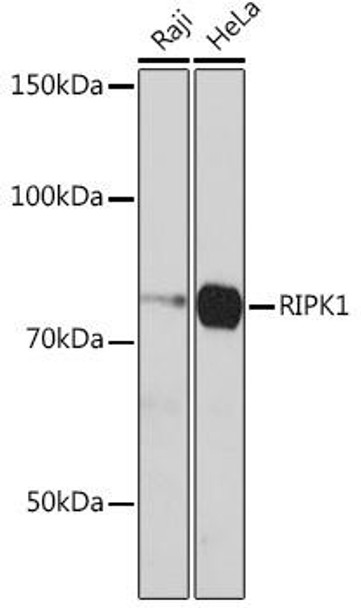Anti-RIPK1 Antibody (CAB19580)
- SKU:
- CAB19580
- Product type:
- Antibody
- Reactivity:
- Human
- Reactivity:
- Mouse
- Host Species:
- Rabbit
- Isotype:
- IgG
- Research Area:
- Cell Death
Description
| 抗体名: | Anti-RIPK1 Antibody |
| 抗体コード: | CAB19580 |
| 抗体サイズ: | 20uL, 50uL, 100uL |
| 申し込み: | WB IP |
| 反応性: | Human, Mouse |
| 宿主種: | Rabbit |
| 免疫原: | A synthesized peptide derived from human RIPK1. |
| 申し込み: | WB IP |
| 推奨希釈: | WB 1:500 - 1:2000 IP 1:50 - 1:200 |
| 反応性: | Human, Mouse |
| ポジティブサンプル: | Raji, HeLa |
| 免疫原: | A synthesized peptide derived from human RIPK1. |
| 精製方法: | Affinity purification |
| ストレージバッファ: | Store at -20°C. Avoid freeze / thaw cycles. Buffer: PBS with 0.02% sodium azide, 0.05% BSA, 50% glycerol, pH7.3. |
| アイソタイプ: | IgG |
| 順序: | Email for sequence |
| 遺伝子ID: | 8737 |
| Uniprot: | Q13546 |
| セルラーロケーション: | Cell membrane, Cytoplasm |
| 計算された分子量: | 75kDa |
| 観察された分子量: | 75KDa |
| 同義語: | RIP, RIP-1, RIP1, RIPK1 |
| バックグラウンド: |
| UniProt Protein Function: | RIPK1: Serine-threonine kinase which transduces inflammatory and cell-death signals (necroptosis) following death receptors ligation, activation of pathogen recognition receptors (PRRs), and DNA damage. Upon activation of TNFR1 by the TNF-alpha family cytokines, TRADD and TRAF2 are recruited to the receptor. Ubiquitination by TRAF2 via 'Lys-63'-link chains acts as a critical enhancer of communication with downstream signal transducers in the mitogen-activated protein kinase pathway and the NF-kappa-B pathway, which in turn mediate downstream events including the activation of genes encoding inflammatory molecules. Polyubiquitinated protein binds to IKBKG/NEMO, the regulatory subunit of the IKK complex, a critical event for NF-kappa-B activation. Interaction with other cellular RHIM-containing adapters initiates gene activation and cell death. RIPK1 and RIPK3 association, in particular, forms a necroptosis-inducing complex. Interacts (via RIP homotypic interaction motif) with RIPK3 (via RIP homotypic interaction motif); this interaction induces RIPK1 necroptosis-specific phosphorylation, formation of the necroptosis-inducing complex. Interacts (via the death domain) with TNFRSF6 (via the death domain) and TRADD (via the death domain). Is recruited by TRADD to TNFRSF1A in a TNF-dependent process. Binds RNF216, EGFR, IKBKG, TRAF1, TRAF2 and TRAF3. Interacts with BNLF1. Interacts with SQSTM1 upon TNF-alpha stimulation. May interact with MAVS/IPS1. Interacts with ZFAND5. Interacts with RBCK1. Interacts with BIRC2/c-IAP1, BIRC3/c-IAP2 and XIAP/BIRC4. Inhibited by necrostatin-1. Belongs to the protein kinase superfamily. TKL Ser/Thr protein kinase family. 2 isoforms of the human protein are produced by alternative splicing. |
| UniProt Protein Details: | Protein type:Protein kinase, Ser/Thr (non-receptor); Kinase, protein; EC 2.7.11.1; Protein kinase, TKL; TKL group; RIPK family Chromosomal Location of Human Ortholog: 6p25.2 Cellular Component: mitochondrion; cytoplasm; cytosol; receptor complex; lipid raft Molecular Function:identical protein binding; protein serine/threonine kinase activity; protein binding; ubiquitin protein ligase binding; death receptor binding; protein complex binding; ATP binding; protein kinase activity Biological Process: caspase activation; positive regulation of I-kappaB kinase/NF-kappaB cascade; protein heterooligomerization; positive regulation of apoptosis; apoptosis; MyD88-independent toll-like receptor signaling pathway; protein amino acid autophosphorylation; positive regulation of JNK cascade; negative regulation of I-kappaB kinase/NF-kappaB cascade; toll-like receptor 3 signaling pathway; positive regulation of tumor necrosis factor production; activation of JNK activity; activation of NF-kappaB transcription factor; positive regulation of interleukin-8 production; positive regulation of programmed cell death; tumor necrosis factor-mediated signaling pathway; cellular protein catabolic process; toll-like receptor signaling pathway; positive regulation of interferon type I production; innate immune response; positive regulation of transcription from RNA polymerase II promoter; positive regulation of protein amino acid phosphorylation; positive regulation of macrophage differentiation; toll-like receptor 4 signaling pathway; protein homooligomerization |
| NCBI Summary: | This gene encodes a member of the receptor-interacting protein (RIP) family of serine/threonine protein kinases. The encoded protein plays a role in inflammation and cell death in response to tissue damage, pathogen recognition, and as part of developmental regulation. RIPK1/RIPK3 kinase-mediated necrosis is referred to as necroptosis. Genetic disruption of this gene in mice results in death shortly after birth. [provided by RefSeq, Aug 2017] |
| UniProt Code: | Q13546 |
| NCBI GenInfo Identifier: | 57242761 |
| NCBI Gene ID: | 8737 |
| NCBI Accession: | NP_003795.2 |
| UniProt Secondary Accession: | Q13546,Q13180, Q59H33, A0AV89, B2RAG1, B4E3F9, |
| UniProt Related Accession: | Q13546 |
| Molecular Weight: | 75931 MW |
| NCBI Full Name: | receptor-interacting serine/threonine-protein kinase 1 isoform 1 |
| NCBI Synonym Full Names: | receptor interacting serine/threonine kinase 1 |
| NCBI Official Symbol: | RIPK1 |
| NCBI Official Synonym Symbols: | RIP; RIP1; RIP-1 |
| NCBI Protein Information: | receptor-interacting serine/threonine-protein kinase 1 |
| UniProt Protein Name: | Receptor-interacting serine/threonine-protein kinase 1 |
| UniProt Synonym Protein Names: | Cell death protein RIP; Receptor-interacting protein 1; RIP-1; Serine/threonine-protein kinase RIP |
| Protein Family: | Receptor-interacting serine/threonine-protein kinase |
| UniProt Gene Name: | RIPK1 |
| UniProt Entry Name: | RIPK1_HUMAN |


